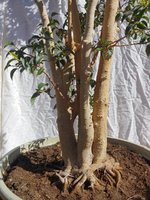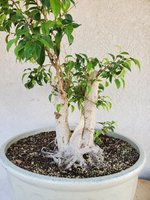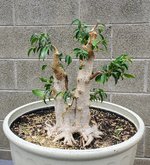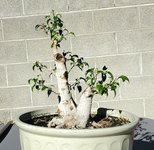luvinthemountains
Chumono
Here is a large ficus benjamina that I have been working down from a houseplant for a few years. I bought this at an incredible nursery in Salt Lake that has since closed down, probably around 10 years ago. It was about 7 feet tall and had smallish leaves (could be Natasja?) that made me wonder how it would do as a bonsai. So two years ago, I layered off one of the trunks that has continued on as a houseplant next to my bedroom window, at a much more manageable size. The stump had three roughly equally-sized trunks that I struggled to know what to do with, and they had all self-grafted to each other at various points. In the end, I decided last year to chop off the middle trunk and carve it to where it met the right-hand trunk to give that one some taper. From there, it was chop and grow, chop and grow to build the next trunk sections. Every time it grows afterward into a pretty bush, and my wife gets made when I butcher it all over again. The last photo is from yesterday. Chopped again, sealed the cuts, and carved/resealed the wound where the third trunk was removed. That wound has been very slow to heal despite the massive growth up above, and I think it could have to do with my failure to seal it. The other wounds where I applied liquid-type cut paste are healing over rapidly, so let's see if this does the trick.







